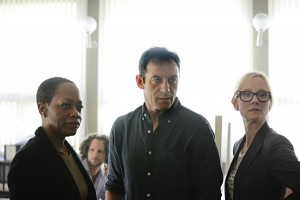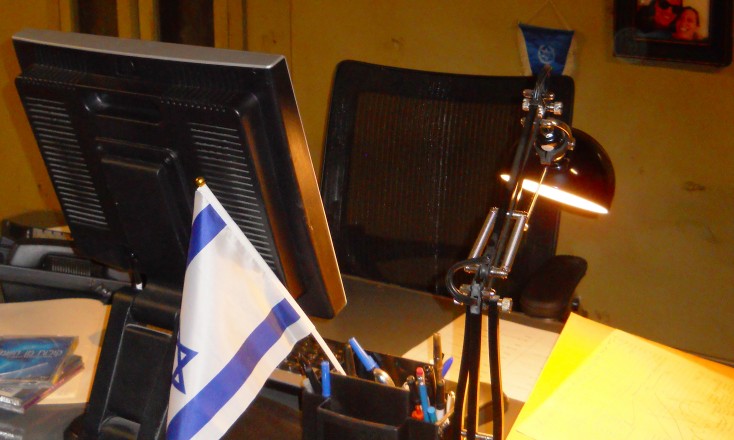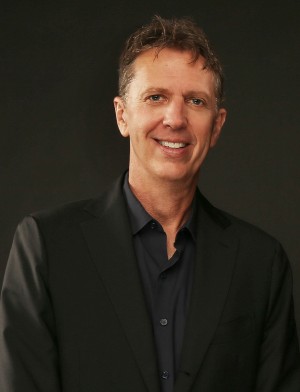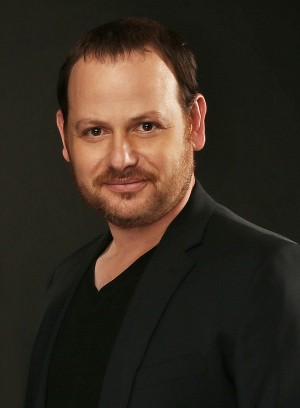By LYNN BARKER
Front Row Features
Albuquerque, N.M.—On Thursday, March 5, the USA cable network premieres its 10-episode adventure/conspiracy thriller event series “Dig,” which will take viewers around the world and sharpen their mystery-solving skills while shaking their core beliefs as never before.
On a set visit here last December, co-creators Tim Kring (“Heroes”) and Gideon Raff (“Homeland”) and cast Jason Isaacs, Anne Heche and Israeli actor Ori Pfeffer spoke about the new series.
Producer/creator Tim Kring describes the series, which takes audiences from Jerusalem to Norway and New Mexico, as a real thrill ride. Fans of murder mysteries, suspense, exotic locations and action are in for a treat, as are those who enjoy solving complex puzzles. All will gravitate to “Dig.”[private]
A murder at an archeological dig site in Jerusalem full of ancient religious artifacts brings in FBI legal attaché Peter Connelly (Isaacs) to investigate, which he does reluctantly, alongside local police detective Golan Cohen (Pfeffer), while keeping his boss and occasional lover Lynn Monahan (Anne Heche) informed of his progress.
The show is full of interesting, flawed characters with past trauma in their lives unraveling a 2,000 year-in-the-making conspiracy. The series’ creators researched their subject well and as series co-creator Raff told us, “You’ll be amazed at how much the story is based on real theories and findings” and reflects the fanaticism embodied in various organizations in the news today.
The production was originally intended to shoot entirely in Jerusalem but when missiles started flying above their heads, the cast and crew moved to Croatia, recreating their sets there and finishing up production on stages in here in Albuquerque, where Kring led select journalists a tour of a stark, grey cement bunker in the desert housing a radical religious cult, an Israeli police station, Connelly’s very casbah-like hotel bedroom and the sleek, ‘60’s-influenced U.S. Consulate offices. All of the actors commented that it was a little disorienting to enter a set in Jerusalem and finish the scene coming out in New Mexico.
We watched from “video village” as Heche and Isaacs shot a scene in which they worry that they might be surrounded at work by conspirators. They wonder if everybody is in on this. Intriguing!
Kring answered some key questions about the show and, later, both he and co-producer/director Gideon “Giddy” Raff spoke with us over lunch.
Q: Doesn’t the title of this show have more than one meaning?
Kring: The initial setting is around an archeological dig but the title, for us, had more to do with the idea of digging the layers of a mystery and digging for the truth and digging for the layers of your own psyche. I hope that the audience sees that. I like one-word titles. (He previously created the NBC TV series “Heroes.”)
Q: What have been the biggest challenges for you getting the show made?
Kring: Obviously, we’ve had logistic problems. How often to have a war breaking out in the middle of a shoot? We were then forced to make some big moves and re-conceive things. It’s interesting; the usual things that go wrong on a show didn’t on this. The stories worked. The actors were great. They weren’t prima donnas. And you didn’t get characters together that have no chemistry. We had problems like “Oh, there are missiles flying outside!”
Also trying to find the American southwest in Israel was nearly impossible. We were driving all over the country trying to find a classic motel or diner. Then you come here (Albuquerque) and you could not swing a dead cat without finding one of those. It became so easy to do that part of the story here. The challenge has been finding a realistic location for everything. Then duplicating the same set in different countries has been a challenge.
Q: At what point in the series shoot were you when you knew you had to leave Israel?
Kring: We had wrapped the pilot and were in prep on the next two episodes. It was the day we were going to shoot all the inserts for the pilot that missiles were fired over Tel Aviv. We were planning to film the whole thing there. The biggest Israeli TV network was part of it so it was a huge disappointment for all of us.
Q: What is the advantage of an “event” series like this over an open-ended TV series?
Kring: It’s shot in a different way. You hire all the writers up front and write all the episodes (and) then you produce them so you’re able to cross-board, meaning you can shoot scenes from Episode 3 and Episode 6 and Episode 9 all on the same set, which is the way a movie works, so it’s shot more like a big movie. It turns out that Gideon can direct three-quarters of it himself, so it has a single vision. S.J. Clarkson created (the vision with the pilot) very closely with me and Gideon.
Q: Are you concerned about nudging some people who might be sensitive to some of the material covered in the show?
Kring: Religion is such a touchy subject and people will see through whatever lens they want to see this. You ask yourself, “Do you just not do it because of that?” We take no stand on this other than it is a point of view about fanaticism. Fanaticism, in any form, is very dangerous. In the world we live in today, we all need to recognize it and talk about it. If we don’t, it’s going to get really, really ugly. We’re seeing that every day. We don’t take a stand on any particular religion. There are fanatics on all sides.
Q: Is there room for a sequel here?
Kring: It really is a story about a legal attaché, and that is always an FBI agent stationed in foreign countries in the consulate who investigates crimes against and by American citizens on foreign soil. It opens up the world to anything. (Isaacs’ character Peter) happens to be stationed in Jerusalem and he happened to be buddied up with an Israeli cop but he could be stationed in another part of the world.
Q: How did you decide you wanted to make films or TV and tell stories?
Raff. I grew up in Jerusalem and always wanted to tell stories. I started as a writer. I’m a novelist in Israel. Then I went to an acting-for-directors school. I then went to New York and took some classes with Stella Adler about directing. In the beginning, it was all about theater—not so much film and television but all about telling stories in different ways. Writing was a means to direct. But I’m very miserable when I don’t write.
Q: How did you team up with Tim Kring?
Raff: I was working on a show called “Tyrant” and I wanted a partner on “Dig.” I’m a big fan of Tim’s. I thought he would be perfect for this because we’re telling stories from different points of view and they all converge. Tim does that brilliantly. The minute I met him, we’re so much in sync about how to tell a story and what we liked that it’s a match made in heaven. It’s a relationship with no ego. If it’s a good idea, it goes into the script.

(l-r) Regina Taylor as Ruth Ridell, Jason Isaacs as Peter Connelly, Anne Heche as Lynn Monahan in the USA Network show DIG. ©USA Network. CR: Ronen Akerman/USA Network.
Q: You use the color red sparingly in this. Why?
Raff: Red plays a big part in our show. We do have a very specific color palate for each one of our worlds; Norway is more greenish and white and cold. At the cult facility in New Mexico, we’re going with blues and grays. The world in Jerusalem is very yellow and noisy and claustrophobic and paranoid and dirty. We don’t use red at all but in very specific places.
Q: You have strong female characters. Your ambassadors are women, for example. Why is that?
Raff: I’ve met some very amazing, strong female ambassadors. The U.S. Ambassador to the U.N., Samantha Power is an amazing woman. I had dinner with her. In “Prisoners of War” (his Israeli TV series that inspired the U.S. series, “Homeland”), I invented a female prime minister for Israel. So, yeah, those things are very cool.
Q: Can you talk about the relationship between Peter Connelly (Isaacs) and Lynn Monahan (Heche)? It seems complicated.
Raff: What I like about it is it’s a grown up relationship. It’s not a TV relationship. It’s two people who don’t want to be together but find themselves in each other’s arms now and, then, because they are very good friends and work well together and sometimes go to bed together, but not in romantic hope that this will end in marriage or anything like that. Peter is separated from his wife. He’s dealing with a complex relationship there. And Lynn doesn’t want this damaged man as her man. She just wants to bed him now and then. It’s two strong people who are both damaged in their own ways who don’t want love but have needs. That gets complex. As the series progresses, they need each other in ways they hoped they wouldn’t.
Q: Can you talk about directing a lot of the series’ episodes?
Raff: I directed six out of the ten and then parts of other episodes, yes. It’s not such a stretch for me because, in Israel I write and direct my whole show, so all 24 episodes of “Prisoners of War” were written and directed by me. But that’s not the way it works in American television so it’s very much due to USA’s trust and Tim’s backing that I was able to direct (Episodes) 2 and 3. They were very happy with the result, and they gave me more episodes. It’s a blessing.
Q: You researched a lot of myths or religious beliefs. Was there something interesting you had to reject as an addition to the show?
Raff: There’s a lot of stuff out there. We could pick and choose. At the end of the day, a secret society started to form and a secret plan and a conspiracy started to form. A lot of cool stuff we wanted to fit in just didn’t fit in with that anymore.
Q: Can you talk about casting Jason Isaacs as Peter Connelly?
Raff: From the very first inception of the idea, we were looking for a guy who is a leading man but also has trauma behind his eyes, (and) has depth and age and life experience. We wanted someone who can be dark, and we kept going back to Jason. Before the pilot was written, we met at our agent’s house. We saw Jason and said, “We have a project and we’re thinking of you.” He was like, “Yeah, sure,” and a year later he was ours, and he’s fantastic. He embodies Peter, not only as an actor but (as) a lead actor (he) really does set a tone on set. Jason’s energy and positivity and good mood all the time energizes the set.[/private]







